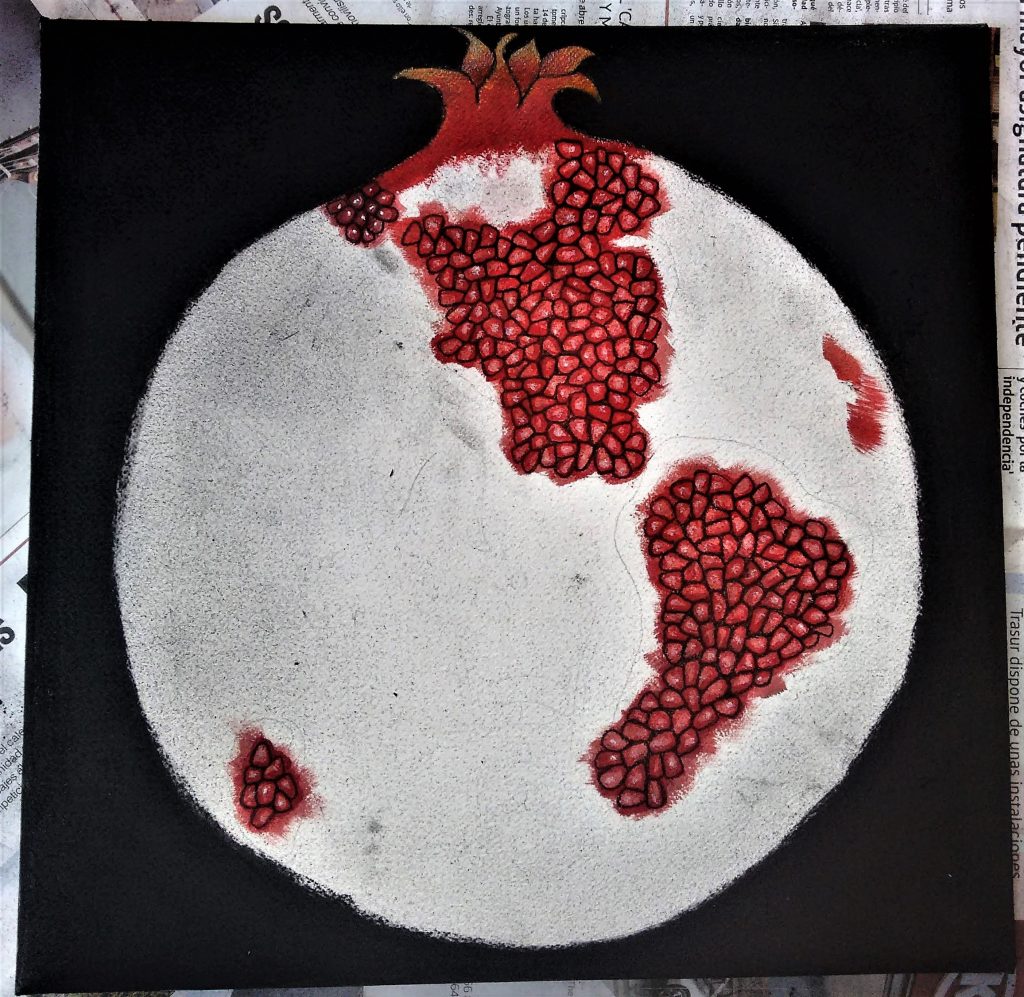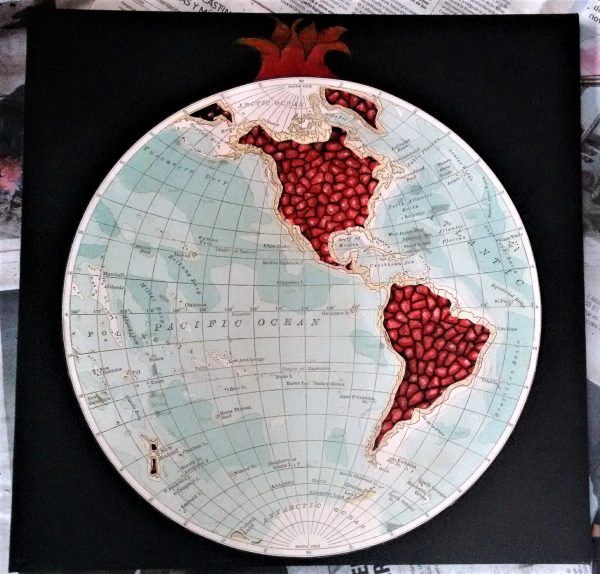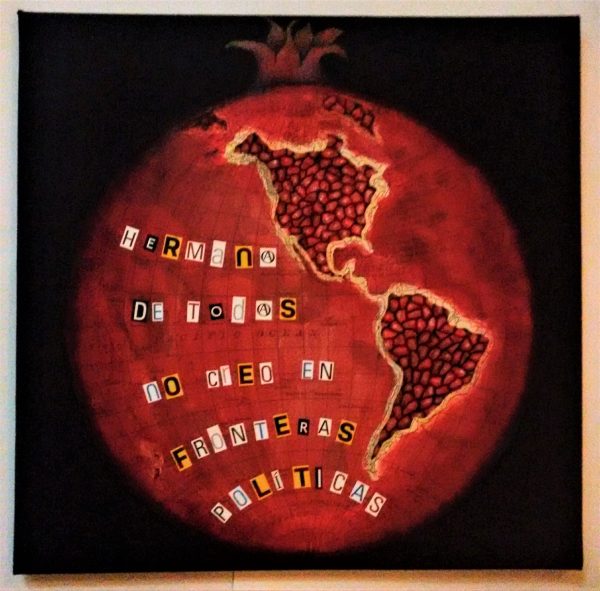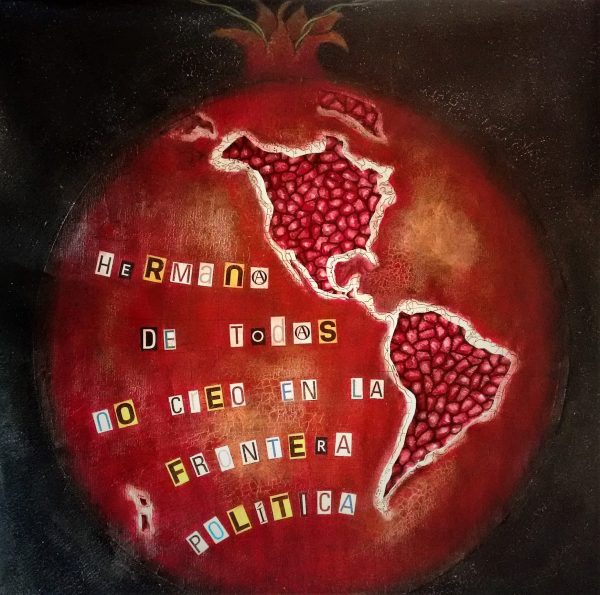Arte Vejer recently staged a group exhibition of artworks made by local artists inspired by the Spanish poet Federico García Lorca who was murdered 80 years ago on the orders of Franco the fascist dictator.
Lorca was born on the 5th June (the same day as me) in 1898 (several years before me) in a small town close to Granada. That’s why I chose the pomegranate as the theme for my collage; granada means pomegranate in Spanish and the ancient town was renamed after the fruit during the Moorish period.
The pomegranate is also a symbol of abundance and fertility which aptly describes Lorca’s imagination, passion and creative genius; he was a prolific writer, considered to be one of Spain’s most important poets and published his first book at the age of 21.
The first stage of the process (above) was to blacken the background (paper on cardboard) and outline the pomegranate seeds with layers of charcoal.
Lorca moved to Madrid in 1919 and devoted himself entirely to his art which was infused with the flamenco culture of his native Andalusia. He was a contemporary of Buñuel and Dalí who introduced him to surrealism. Lorca and Dalí had a particularly intimate relationship involving ‘love, passion and respect‘ but it is rumoured that Dalí’s aversion to physical contact and his repressed sexuality led him to reject Lorca’s advances.
I painted the seeds and persistent calyx (the bit at the top of the fruit) with acrylic.
In 1929 Lorca left Spain to spend a year in New York where he was inspired by the African-American spirituals he heard in Harlem, his favourite part of the city.
Next I collaged a map of the world over the background (above), this represents the international reach of Lorca’s work and art in general as well as his time abroad. I then painted over it with acrylic.
The text is an extract from one of Lorca’s last interviews.
Here’s the full quote in Spanish:
“Yo soy español integral y me sería imposible vivir fuera de mis límites geográficos; pero odio al que es español por ser español nada más, yo soy hermano de todos y execro al hombre que se sacrifica por una idea nacionalista, abstracta, por el sólo hecho de que ama a su patria con una venda en los ojos. El chino bueno está más cerca de mí que el español malo. Canto a España y la siento hasta la médula, pero antes que esto soy hombre del mundo y hermano de todos. Desde luego no creo en la frontera política.”
And translated into English
“I am Spanish through and through and it would be impossible for me to live outside my geographic boundaries; but I hate those Spanish people who are merely Spanish and nothing more, I am brother to all and abhor the man who sacrifices himself to an abstract nationalist idea purely because he blindly loves his homeland. I feel closer to the good Chinese man than the bad Spanish man. I sing to Spain and feel her in my marrow, but before that I am a man of the world and brother of all. Of course I don’t believe in political borders.”
The quote really sang to me when I came across it; it seems particularly apposite in these times of Brexit and Trump when ugly nationalism and bigotry are on the rise again.
I cut the letters for the text from magazines and stuck them down in the style of an old fashioned ransom note (above) as a reference to the fact that Lorca was abducted before being killed by a falangist firing squad.
I added ‘A’s to the ‘O’s of ‘hermano’ and ‘todos’ to explicitly make the words gender neutral which also happily turned those letters into anarchist symbols.
Next I painted electrical cables emerging from the calyx of the pomegranate (below) to turn it into a fairy light. I made this piece just before Christmas so it was seasonally apt (although I am a huge fan of the year round fairy light) and it also suggests that the earth is but a bauble hanging in the vastness of the universe and that we humans take our opinions about our piffling differences far too seriously.
The final stage of the process (below) was to paint crackle glaze over the whole of the image before applying bitumen, gold paint and glitter as stains.
Lorca was staying at his family’s country home just outside Granada when the civil war started in 1936. About a month before his incarceration and murder on August 19th Lorca had a disturbing dream in which he was being menaced by a group of grieving women waving black crucifixes.
Archaeologists are still searching for the exact burial site of Lorca’s body.





